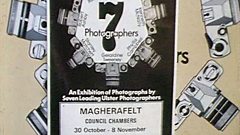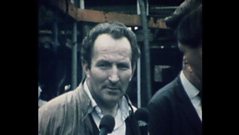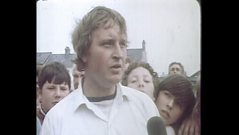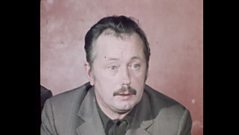
The killing of Fr Hugh Mullan
Bishop William Philbin reflects on the death of Fr Hugh Mullan who was shot dead during riots in West Belfast following the introduction of internment without trial in August 1971.
John Humphrys interviews Bishop William Philbin the day after Fr Hugh Mullan was shot dead by a soldier from either the 2nd Battalion Parachute Regiment or the 2nd Battalion Queen’s Regiment. The shooting took place during riots in the Springfield Park area of West Belfast following the introduction of internment without trail by Brian Faulkner’s Unionist government on 9 August 1971. (Please see context below)
Humphrys speaks to Bishop Philbin in the gardens of Lisbreen, the official residence of the Bishop of Down and Connor in North Belfast. In reflecting on the death of Fr Mullan, Dr Philbin says that as a priest he had consecrated his life to the service of God and people. It would be a tragedy if his death were used in the furtherance of hatred. In response to a question on whether the Church should be doing more to stop the violence, Dr Philbin says that since the troubles broke out in 1969 priests have been exercising all the influence they can to reduce tension, but there is a limit to what the Church can do. The Church is interested primarily in morality and not politics, he says.
Fr Mullan was a priest at Corpus Christi Church in Ballymurphy. During the afternoon of 9 August he had tried to reduce sectarian tensions in the neighbourhood but was ignored. Later that evening, he was monitoring events from his home at 45 Springfield Park with his colleague Fr Felix McGuckin when he responded to people calling for help. A man was shot. The man, later identified as Bobby Clarke, had just lifted a child to safety. According to Fr McGuckin these events took place at around 9.15pm. Fr Mullan phoned the local army HQ and told them he was going out to give the last rites of the Catholic Church to the stricken man who was lying in a nearby field. While giving Bobby Clarke the last rites he realised he was not mortally wounded. Fr Mullan was shot while making his way back to call an ambulance. He was waving a white cloth. Another resident, Frank Quinn, who had run out to help Clarke was also shot dead. During 3 separate days of social disturbance in the Upper Springfield area 11 people were killed by the army. The killings have become known as the Ballymurphy massacre and the relatives of those who died are calling for an independent investigation.
Context
In the early hours of Monday morning, 9 August 1971, the Army and police set off in a widespread series of arrest operations in towns around Northern Ireland. During the first morning of ‘Operation Demetrius’, 342 people were arrested; just over a hundred of them were released two days later. The detainees were imprisoned in Crumlin Road Prison and on the Maidstone, a soldiers’ billet turned into a prison ship, at Belfast docks.
The Prime Minister, Brian Faulkner, had been facing mounting criticism of his security policies from within his own party, and felt that his only option was to introduce internment without trial to counteract IRA attacks. It was a tactic that he had used successfully against the IRA during the late 1950s; but in 1971, it proved a serious security and political blunder. This time the security forces were operating on out-dated RUC intelligence. In addition, internment intensified the violence. In the three days following the introduction of internment 25 people were killed, the majority shot by the Army. The Parachute Regiment was responsible for 11 deaths in the Springfield area in Belfast alone, including Father Hugh Mullan, shot while administering the last rites to an injured man and Joan Connolly a mother of eight; about 240 houses in Ardoyne were destroyed by fire; a member of the UDR was shot dead in Co Tyrone; and Londonderry experienced protracted rioting as more than 30 barricades were put up in the Creggan and the Bogside.
Most of the new leadership of the IRA escaped the army raids, and – with the exception of two Protestant civil rights activists, Ronnie Bunting and John McGuffin – the measure was used exclusively against the Catholic community. The fact that no loyalists were arrested increased the Catholic community’s sense of grievance. Subsequent allegations of torture against the people arrested led to an upsurge in recruitment to the IRA and an increase in sympathy and finance for the IRA at home and abroad, particularly from some among the substantial Irish-American community in the United States.
Up to 9 August, 34 people had died in the violence that year. Only three days after the introduction of internment, 25 more people had been killed. Among the dead was Winston Donnell, the first member of the Ulster Defence Regiment to be killed. Thousands of people had been forced to leave their homes in Belfast because of sectarian attacks and many Belfast Catholics left the city for refugee camps across the border.
In the first six months of internment, nearly 2,400 people were arrested; of these 1,600 were released after interrogation. The Army admitted years later that internment was a major mistake.
Duration:
This clip is from
More clips from Scene Around Six
-
![]()
Oxford Street Bus Station—21/07/1972
Duration: 00:50
-
![]()
Cavehill Road bomb—21/07/1972
Duration: 02:32
-
![]()
IRA challenge Whitelaw—13/06/1972
Duration: 01:07





